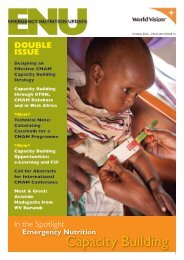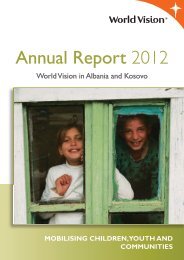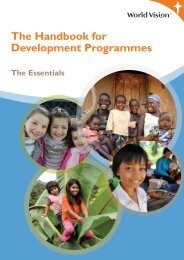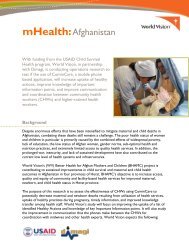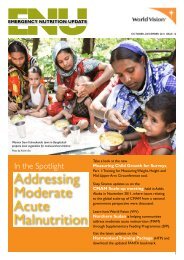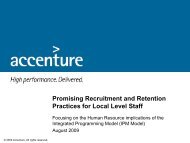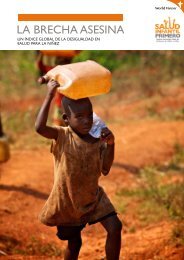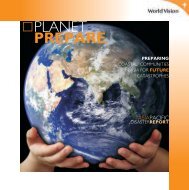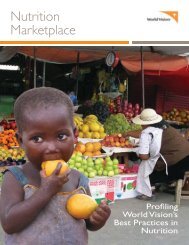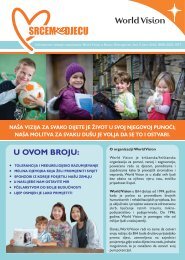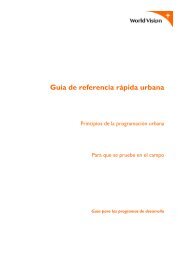Institute of Deaf Students, after 1990 were integrated or involved in <strong>the</strong> care services that <strong>the</strong>societies of <strong>the</strong> countries where <strong>the</strong>ir families had already settled provided.2. Changes influencing <strong>the</strong> society affected <strong>the</strong> make up of Albanian families in <strong>the</strong> trans<strong>for</strong>mationof large families in<strong>to</strong> smaller ones. This created more opportunities <strong>to</strong> provide care <strong>for</strong> <strong>children</strong>,increased awareness of parents <strong>to</strong> ensure <strong>children</strong>’s welfare. Likewise, internal migration, mainly fromnor<strong>the</strong>rn and rural areas <strong>to</strong> urban areas, created more access <strong>to</strong> benefit from early interventionand prevention programs. More <strong>children</strong> were involved in regular vaccination programs andcontinuous health control enabling <strong>the</strong> number of <strong>children</strong> affected by illness or problems causedby German measles or <strong>the</strong> prolonged treatment <strong>with</strong> antibiotics (both causing hearing problems)be lowered significantly.3. Establishment and consolidation of many centers, <strong>with</strong> <strong>the</strong> support of state and nongovernmentalorganizations, caused a certain number of <strong>children</strong> who had previously attended <strong>the</strong> Institute ofDeaf Students, benefit from <strong>the</strong> services offered by <strong>the</strong>se centers.While in o<strong>the</strong>r countries, services <strong>for</strong> this category of <strong>children</strong> were strongly supported by religiousorganizations and <strong>the</strong> church, just as <strong>the</strong>ir <strong>education</strong>al needs were realized <strong>with</strong> <strong>the</strong> help of <strong>the</strong>se institutions,<strong>the</strong> fact that Albania was an a<strong>the</strong>ist and its school secular, made <strong>the</strong> religion and religious organizations ou<strong>to</strong>f reach <strong>to</strong> offer support.After a long hiatus, associated <strong>with</strong> <strong>the</strong> creation of new opportunities <strong>for</strong> change and development of <strong>the</strong>seinstitutions, in 1989 <strong>the</strong> Minister of Education of that time Mr. Skënder Gjinushi provided scholarships <strong>for</strong>some of <strong>the</strong> specialists working in <strong>the</strong> disability field. This was <strong>the</strong> first initiative after a long halt, caused bydisestablishment of relationships <strong>with</strong> twin countries of <strong>the</strong> socialist camp. So in February 1989, a group ofspecialists from Albania went on a scholarship program <strong>to</strong> Italy <strong>for</strong> a period of 6 months, until June 1989.The group was composed of: Mr. Virgil Nano, at that time direc<strong>to</strong>r of special <strong>education</strong> “Louis Gurakuqi” inTirana, Mrs. Fatima Kapo, deputy direc<strong>to</strong>r in <strong>the</strong> same school, Mrs. Lindita Klimi, a teacher at <strong>the</strong> Institute ofDeaf Students and Mrs. Liljana Nano, a teacher at <strong>the</strong> Institute of Blind Students.This initiative was supported by ano<strong>the</strong>r enterprise of this nature. Some months later, two teachers <strong>for</strong>blind students (Mrs. Vera Skëndo and Mrs. Luiza Shtjefni) were sent <strong>to</strong> France <strong>with</strong> scholarships <strong>to</strong> learnfrom <strong>the</strong> French experience in handling <strong>the</strong> <strong>education</strong> of <strong>children</strong> <strong>with</strong> visual impairments. In 1993, <strong>for</strong><strong>the</strong> first time in Albania by some specialists of language and communication, was first compiled <strong>the</strong> signsbook. This book was <strong>the</strong> result of a large collaborative work of <strong>the</strong> specialist Mrs. Lindita Klimi and <strong>the</strong>representative of <strong>the</strong> Dutch Foundation “Efata” Mrs. Ineke Honne.On September 20, 2005, <strong>the</strong> Ministry of Education of <strong>the</strong> time, by an official instruction required expansionof <strong>the</strong> curriculum <strong>for</strong> <strong>children</strong> <strong>with</strong> hearing impairment that were receiving <strong>education</strong> in <strong>the</strong> Institute ofDeaf Students. This instruction paved <strong>the</strong> way <strong>for</strong> <strong>the</strong> application of practices and methods aimed atintegrating special <strong>education</strong> curriculums <strong>with</strong> <strong>the</strong> curriculums of basic <strong>education</strong> schools. In this period,in <strong>the</strong> Institute of Deaf Students it was experimented <strong>the</strong> prepara<strong>to</strong>ry class <strong>for</strong> <strong>children</strong> enrolled in thisinstitution.Until early 1990, <strong>the</strong> only method used <strong>to</strong> teach <strong>children</strong> <strong>with</strong> hearing problems was <strong>the</strong> verbal one(through lips reading). Students and teachers were categorically <strong>for</strong>bidden <strong>to</strong> use nonverbal communication,gestures, or body language. Students were obliged <strong>to</strong> keep <strong>the</strong>ir hands under desks <strong>to</strong> avoid using <strong>the</strong>mduring class sessions. Moreover, it was <strong>for</strong>bidden <strong>to</strong> use signs as a means of communication. After 1990scontemporary methods were applied and school curricula <strong>for</strong> this category of <strong>children</strong>, underwentsubstantial modifications. A mixed set of methods were used in order <strong>to</strong> make possible <strong>the</strong> involvemen<strong>to</strong>f <strong>children</strong> in <strong>the</strong> learning process and <strong>to</strong> ensure effective teaching and learning. Nowadays, in schoolcurricula of <strong>the</strong> <strong>education</strong>al institution, <strong>the</strong> method of global communication is being used including verbalcommunication, gestures and dactylology.The establishment and operation of <strong>the</strong>se two institutions <strong>for</strong> students <strong>with</strong> visual and hearing problems,it covers almost <strong>to</strong> a full extent <strong>the</strong> whole country needs <strong>for</strong> <strong>the</strong> categories of students <strong>the</strong>y specialize oneducating.20 The <strong>right</strong> <strong>to</strong> Inclusive Education <strong>for</strong> <strong>children</strong> <strong>with</strong> Disabilities
The opening of residential centers and special schoolsFor <strong>children</strong> <strong>with</strong> o<strong>the</strong>r problems in <strong>the</strong>ir development (mental retardation, cerebral palsy, etc.), <strong>the</strong> Ministryof Health of that time, established some residential centers (institutions <strong>with</strong> dorms). These institutionstypically expressed an outdated model of a politically centralized government. In <strong>the</strong> recent years, <strong>the</strong>seinstitutions have come under <strong>the</strong> authority of <strong>the</strong> Ministry of Labor, Social Affairs and Equal Opportunities.after <strong>the</strong> year 1970 in <strong>the</strong> cities where <strong>the</strong>re were already psychiatric hospitals, <strong>the</strong>re were openedschools <strong>for</strong> students <strong>with</strong> mild mental retardation. The need <strong>to</strong> open <strong>the</strong>se schools was influenced by takingmeasures <strong>to</strong> cope <strong>with</strong> <strong>the</strong> numerous abandoning of school from students <strong>with</strong> <strong>disabilities</strong> who could notmanage <strong>to</strong> complete <strong>the</strong> 8-year <strong>education</strong>, although by now it had turned in<strong>to</strong> a compulsory <strong>education</strong>.Under <strong>the</strong>se conditions it was necessity <strong>the</strong> establishment and consolidation of special schools <strong>for</strong> <strong>children</strong><strong>with</strong> mild mental <strong>disabilities</strong>. For <strong>the</strong>se schools special curricula were designed. Initially <strong>the</strong>se schools wereopened in Tirana, Vlora, Elbasan and later in Shkodra, Durrës and Korça.his<strong>to</strong>ry of opening of <strong>the</strong> special school “luigj gurakuqi” in Tirana(For <strong>the</strong> first time in our country, <strong>with</strong> <strong>the</strong> initiative of a group of specialists in <strong>the</strong> field of disability, onOc<strong>to</strong>ber 17, 1973 was established <strong>the</strong> first special class <strong>for</strong> <strong>children</strong> <strong>with</strong> <strong>disabilities</strong> in <strong>the</strong> city of Tirana.This class originally had only 15 <strong>children</strong> and was opened on <strong>the</strong> 8-year public school premises of “LuigjGurakuqi.” It was <strong>the</strong> commitment of initia<strong>to</strong>ry group (Mrs. Urani Dhimo, Mrs. Liri Gjoliku and Mr. VirgjilNano) and <strong>the</strong> results achieved <strong>with</strong> <strong>the</strong> students in this class, and growing needs <strong>for</strong> <strong>education</strong> of <strong>children</strong><strong>with</strong> <strong>disabilities</strong> that led <strong>to</strong> <strong>the</strong> establishment of a genuine school in 1979 in Tirana, which <strong>to</strong>day is calledspecial school “Louis Gurakaqi”).Albania was <strong>the</strong> fifth country in that time that had set up <strong>the</strong> system of special schools <strong>to</strong> enable <strong>the</strong><strong>education</strong> of <strong>children</strong> <strong>with</strong> <strong>disabilities</strong> and certainly this initiative should be commended and supported,regardless of limitations and ideological constraints of that time. Be<strong>for</strong>e a class would open, <strong>the</strong> initiatinggroup had moni<strong>to</strong>red and observed in <strong>the</strong> nearby schools, <strong>the</strong> students who exhibited academic,behavioral, developmental problems, etc. The first <strong>children</strong> who were enrolled in this class were mostly<strong>children</strong> who had failed <strong>to</strong> assimilate and acquire <strong>the</strong> curriculum of <strong>the</strong> first and second grade. Initially, <strong>the</strong>opening of a special class in <strong>the</strong> premises of a regular 8 - year school, created many problems both <strong>for</strong><strong>the</strong> students of this class and <strong>for</strong> <strong>the</strong> o<strong>the</strong>r students of <strong>the</strong> school as well. Prejudice and stigmatization <strong>for</strong>disability in general and <strong>children</strong> <strong>with</strong> <strong>disabilities</strong> in particular, greatly aggravated <strong>the</strong> situation regarding<strong>the</strong> ongoing of learning <strong>for</strong> <strong>children</strong> <strong>with</strong> <strong>disabilities</strong> in mainstream school environments. O<strong>the</strong>r studentswere in<strong>to</strong>lerant and disapproving <strong>to</strong>wards <strong>the</strong>ir peers <strong>with</strong> <strong>disabilities</strong>. They displayed discrimina<strong>to</strong>ry andexclusive attitudes <strong>to</strong>ward <strong>the</strong>se <strong>children</strong>. Also <strong>for</strong> teachers and staff of this school, this initiative was notwell received. They were reluctant and had low expectations in regard <strong>to</strong> <strong>the</strong> <strong>education</strong> of <strong>children</strong> <strong>with</strong><strong>disabilities</strong>. Special class teachers of that time, say that <strong>the</strong>y had <strong>to</strong> send repeated requests <strong>to</strong> <strong>the</strong> school’sdirec<strong>to</strong>ry, <strong>to</strong> change <strong>the</strong> time of <strong>the</strong> lunch break, so that students <strong>with</strong> <strong>disabilities</strong> were not exposed andfaced in <strong>the</strong> same environment and at <strong>the</strong> same time <strong>with</strong> o<strong>the</strong>r <strong>children</strong> of no <strong>disabilities</strong>. This wouldsomehow avoid discrimination and contempt <strong>to</strong>wards <strong>the</strong>m, but would also certainly, pave <strong>the</strong> way <strong>for</strong><strong>the</strong>ir isolation and segregation. Despite <strong>the</strong> fact that <strong>the</strong> opening of this school marked <strong>the</strong> first changeoriented <strong>to</strong>wards creating opportunities <strong>for</strong> <strong>children</strong> <strong>with</strong> <strong>disabilities</strong> <strong>to</strong> be educated, it carried its risks.Many teachers in mainstream schools at <strong>the</strong> time, began <strong>to</strong> identify as <strong>children</strong> <strong>with</strong> <strong>disabilities</strong>, all those<strong>children</strong> who <strong>for</strong> various reasons could not acquire <strong>the</strong> curriculum, calling <strong>for</strong> <strong>the</strong> continuation of <strong>the</strong>ir<strong>education</strong> in special schools.The first two teachers of <strong>the</strong> special class, taught in an organized way, both in <strong>the</strong> morning and in <strong>the</strong>afternoon. It is worth noting that <strong>the</strong>ir work and commitment was at very high levels. Certainly <strong>the</strong> lack ofexperience in working <strong>with</strong> <strong>children</strong> <strong>with</strong> <strong>disabilities</strong>, had dictated <strong>to</strong> <strong>the</strong>m <strong>the</strong> need <strong>for</strong> <strong>the</strong>ir dedication,maximum commitment and care <strong>to</strong> help and support <strong>the</strong>se <strong>children</strong> in <strong>the</strong>ir <strong>education</strong> process. Theyworked <strong>with</strong> passion and love <strong>with</strong> all <strong>the</strong> <strong>children</strong> in <strong>the</strong>ir class. The teacher who taught during <strong>the</strong>first part of <strong>the</strong> day, marked and recorded in <strong>the</strong> “Journal of Communication” (that is how <strong>the</strong>y called<strong>the</strong> notebook where <strong>the</strong>y pass one-ano<strong>the</strong>r tips and suggestions <strong>for</strong> each student) all <strong>the</strong> students hadThe <strong>right</strong> <strong>to</strong> Inclusive Education <strong>for</strong> <strong>children</strong> <strong>with</strong> Disabilities21



